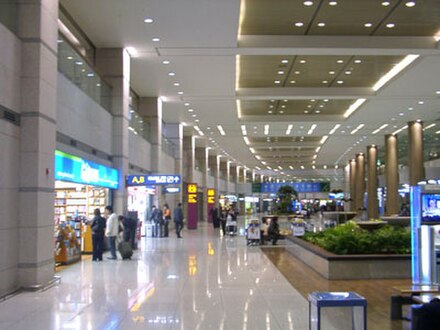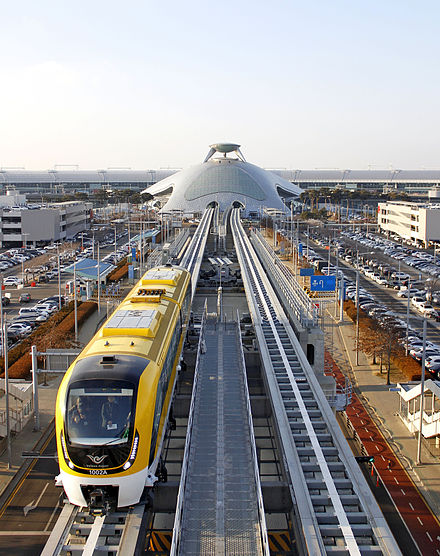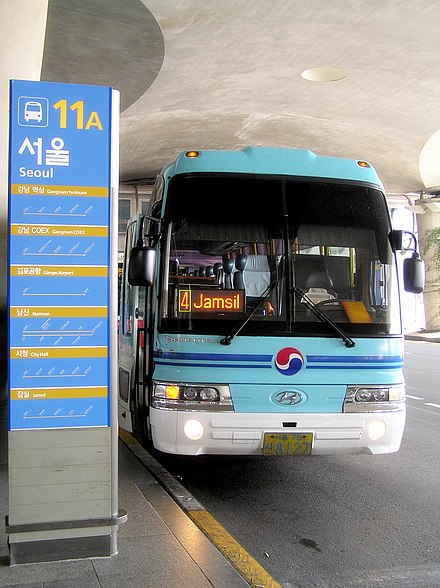Incheon International Airport (인천국제공항) (IATA: ICN) is South Korea's largest airport, its main international gateway, and the main airport of Seoul.
Understand
Incheon International Airport was built to the west of Seoul and opened in 2001, taking over from Seoul Gimpo airport as the nation's international hub. Gimpo is still in operation, serving domestic flights and a few to nearby Asian countries.
 Incheon has comprehensive connections to the South Korean capital, and is frequently rated in the top three airports in the world. The terminal buildings are architecturally very impressive, and are a pleasure to look at, even if you are not flying. The airport is beautiful, meticulously clean and well maintained. There's plenty to keep one occupied while waiting. The nearby city of Incheon is also a significant center of industry.
Incheon has comprehensive connections to the South Korean capital, and is frequently rated in the top three airports in the world. The terminal buildings are architecturally very impressive, and are a pleasure to look at, even if you are not flying. The airport is beautiful, meticulously clean and well maintained. There's plenty to keep one occupied while waiting. The nearby city of Incheon is also a significant center of industry.
A second terminal was opened in time for the 2018 Winter Olympics.
South Korea allows sterile transit; if you are just changing between two international flights, then you do not need to pass through Customs or Immigration and do not need a Korean visa. Just stay on the air side of the terminal and follow signs for "transit passengers" to move from the arrivals to the departure area; there will be a security check (usually with only a short line) but no other formalities.
Flights
Incheon is the main international hub for both Korean Air and Asiana, with many airlines flying from North America, Europe, Africa, Australasia and Asia.
The vast majority of domestic Korean flights, as well as some international flights to China, Japan and Taiwan, are still handled by Seoul Gimpo airport which is a short AREX train journey from Incheon airport.
There are a limited number of direct flights from Seoul Incheon to both Busan's Gimhae International Airport and Daegu every day. These cost slightly more than the corresponding flights from Gimpo, but they are much more convenient if you arrive on an international flight. These are actually treated as international connections, and you will pass immigration later at your destination. As such only passengers connecting to/from an international flight are allowed on these flights.
- Terminal 1: Asiana and all other airlines not in Terminal 2
- Terminal 2: Air France, Delta, KLM, Korean Air, Aeromexico, China Airlines, Garuda Indonesia, XiamenAir, Czech Airlines and Aeroflot - other Skyteam members will move after further expansion
Ground transportation
By train
A'REX (Airport train)
The A'REX train link connects the airport to Seoul Station (for further connections to KTX high-speed services) and Gimpo Airport (most domestic flights), operating from 05:20 until 00:00. There are express services and all-stop services.
 Express services to the city (every 40 minutes) takes 43 minutes (Terminal 1 to Seoul Station) or 51 minutes (Terminal 2 to Seoul Station) and cost ₩9,000/₩7,000 (adult/child) (with WiFi available on board). There is a discounted fare of ₩7,500 for travelers taking a roundtrip within 15 days, groups of three and passengers of certain airlines (see here for more details and discounts).
Express services to the city (every 40 minutes) takes 43 minutes (Terminal 1 to Seoul Station) or 51 minutes (Terminal 2 to Seoul Station) and cost ₩9,000/₩7,000 (adult/child) (with WiFi available on board). There is a discounted fare of ₩7,500 for travelers taking a roundtrip within 15 days, groups of three and passengers of certain airlines (see here for more details and discounts).
All-stop services (every 6 minutes as part of the Seoul Subway system) take an hour and cost ₩4,150 from T1/₩4,750 from T2. It is often faster to just take the All-Stop than wait for the Express train.
The All-Stop and the Express train leave from different platforms and have separate ticket booths.
Travelers coming from Seoul Station to Incheon need to enter the subway area with a T-money or single entry ticket to access the AREX platforms. The cost of the subway ticket is refunded when buying an AREX ticket. The All-Stop train requires a T-money card or single entry ticket, which require cash. The Express train can be paid with credit card as well.
If you are flying with Korean Air, Asiana Airlines, T'Way Air and Jeju Air you can check into your flight at Seoul Station before you get on the AREX Express train if you are there at least 3 hours before your departure time. Immigration officers are also on hand to stamp your passport, which means you are processed and can quickly go through the Diplomatic Departures entrance in Incheon Airport. See City Airport Terminal.
Travel time to Gimpo Airport is 28/35 minutes, with both services charging ₩3,100, making this the fastest and cheapest option for inter-airport transfer as well.
Maglev train
 In February 2016, Incheon opened a new maglev line to the area around the airport. It runs between the airport's Terminal 1 station and Yongyu Station in Youngyu Island, stopping at the airport administration building, long-term parking lots, and a couple of other places along the way. With a maximum speed of 110 km/h, it is not exactly in the same class as the Shanghai Maglev, but may still be interesting to tourists wishing to ride a maglev for the first time or those in town for an event on Yongyu. The train runs every 15 minutes from 09:00 and 18:00, and fares are free for the first few years after opening.
In February 2016, Incheon opened a new maglev line to the area around the airport. It runs between the airport's Terminal 1 station and Yongyu Station in Youngyu Island, stopping at the airport administration building, long-term parking lots, and a couple of other places along the way. With a maximum speed of 110 km/h, it is not exactly in the same class as the Shanghai Maglev, but may still be interesting to tourists wishing to ride a maglev for the first time or those in town for an event on Yongyu. The train runs every 15 minutes from 09:00 and 18:00, and fares are free for the first few years after opening.
KTX
Korea's high speed rail service (KTX) running directly to and from Incheon Airport have been suspended. To use the KTX, take the AREX to Seoul Station or Bus No. 6770 (₩15,000) to Gwangmyeong Station. Bus 6770 is operated by Korail, and there is a ₩3000 discount for the combined ticket for KTX and the bus. City Airport Terminal at Gwangmyeong Station can be faster than going to Seoul station.
By bus

You can purchase and recharge a T-Money card at the GS25 store which is located at the end of the arrivals area, next to "International Arrivals F" exit.
If you have a late flight and plan on getting into Seoul via bus, make sure you get out to the curb as soon as you can. The last buses run shortly after the last flights land. If you miss your bus, you'll be stuck paying for a taxi, as the trains will stop running too.
There are also inter-city and express bus to cities other than Seoul.
By taxi
A taxi direct to Seoul will cost around ₩50,000/70,000 regular/deluxe. Black deluxe taxis (모범 택시) and almost all regular taxis accept credit cards, but a few regular taxis (일반 택시) may not. Ask the driver before you get on if you can pay by credit card. You are expected to pay any road tolls on top of the meter fare. Having your destination written down in Korean will be very helpful. Steer clear of taxi drivers trying to pick you up from inside the terminal and even the bus stop. As both buses and taxis are subject to traffic, allow extra time for rush hour delays (or take the train back).
By car
It is connected by two highways. Incheon International Airport Expressway (No. 130) is connected to Seoul and north of Incheon. Incheon Bridge (No. 110, the longest bridge in South Korea) is for the people heading to the south of Incheon or other parts of region.
City Airport Terminal
At the City Airport Terminal, you can check your bags and even pass through security and immigration, allowing you to skip the lines at the airport and to spend a little longer in the city, or helping you make a mad dash to the airport. It is located at COEX, Seoul Station, and Gwangmyeong Station. Not all airlines operate at City Airport Terminals. Make sure to check.
Get around
There are two terminals. Terminal 1 houses Asiana Airlines, Jeju Air, and some foreign airlines. A separate Concourse is connected to the main terminal 1 by a fast underground train. Terminal 2 has Korean Air, Delta, KLM, Air France, Aeroflot, Aéromexico, China Airlines, Garuda Indonesia, and Xiamen Air. Airside transfer between terminals and concourse is done by a shuttle train. Free shuttle bus between landside of Terminal 1 and 2 is operated, too.
The airport is well signposted and caters to all your traveler needs, and even includes a small mall. It's spread out over five floors:
- 4F: Viewing lounge, upscale restaurants, food court
- 3F: Departures/Transit level, tax-free shopping, fast food
- 2F: Business center
- 1F: Arrival level, tourist information, buses and taxis
- B1F: Starline shuttle (transit side)<br> "Spa on Air" sauna, cafeteria, hospital (land side)
Wait
General
- Incheon is somewhat close to the North Korean border, and dedicated DMZ tours are available if you have some hours to spare.
- A booth in the arrival hall offers "free Korea Transit Tours". See the Visitkorea site (dead link: December 2020) and the airport site for more details. The only downside is that the last trip starts at 15:00. If you have a few hours to spare from 15:00 onwards, you'll have to figure out the trip arrangements yourself. If you want to visit the small Yonggungsa Temple (location #1 on the "free Korea Transit Tours" suggestion), which is not overwhelmed by tourists, the taxi round trip is about US$30 and 40 minutes (two-way travel time). Bus is significantly cheaper, but will take several times as long. The airport information booth can help you plan this trip, or you can use Google Transit to plan this trip. The Google Map friendly address of this Temple is "667 Unnam-dong, Jung-gu, Incheon, South Korea".
- Revive yourself with a reasonably priced Korean sauna experience on the basement level.
- JES Massage Center, 2 locations: Passenger Terminal 4th Floor Rest & Relax Zone & Concourse A, +82 32 743 6925.
- Learn about Korean traditional culture in the dedicated cultural learning center. This is actually very well organized.
- There is also a small museum at the airport that you can walk through in less than 5 minutes.
- There is a lovely garden inside the airport to relax by.
- See the occasional parade going through the airport.
- Virtual reality games
- Areas for kids
- Watch a traditional Korean performance troupe walk through the airport.
- Grab a coffee and surf free internet in the Samsung lounge.
- You can surf the internet free almost anywhere on the airport thanks to free Wi-Fi (hassle free - no registration of any kind required, connect to Airport Wi-Fi network and you are good).
Lounges
- Korean Air has a very large lounge for 'Morning Calm' passengers, equivalent SkyTeam members, Prestige class passengers, and First class passengers. Showers are good, but a long wait is possible during busy times. There are separate lounges for First class and Prestige class.
- Cathay Pacific has a functional lounge with basic refreshments, bathrooms, comfortable seating and fast internet. It does not offer showers. It is in the satellite terminal near the gate for Cathay flights
- Asiana
Eat and drink
Restaurants
Land-side there is a food court named "Food on Air" in the first floor that offers Korean, Chinese and Japanese, and a lot of other menus. It is divided into two parts, which are called "Studio 1" and "Studio 2". The two separate studios have different menus and are popular with airport workers. Also, there is a McDonald and a KFC on the first floor. There is also a Paris Croissant Kitchen, which offers a varied pastas and a variety of breads.
On Incheon Airport Transport Centre, there is a Korean BBQ restaurant named "Bong Pi Yang". Also, there is a small cafe named "MojiTalk", which sells salads and pastas.
Air-side there are some fast food establishments on the ground floor, however the fourth floor above them has higher quality restaurants with good Korean food. Definitely worth trying if you are on a stop-over and want to experience something of Korea's food.
Cafes
There are Starbucks and Gloria Jean coffee outlets on the air-side. For novelty value, there is a new "Hello Kitty" cafe as well.
There is a Starbucks in the basement of the land side, as Coffee Bean & Tea leaf, Dunkin Donuts on the Departure Floor, Floor 2.
Buy
Incheon is a pretty good shopping experience. Duty Free shops offer many products specific to Korea such as Soju (rice wine) and Ginseng root herbal products. All the luxury goods are also available. There are some electronic shops, although not with the range and prices that you would expect of a major electronics player such as South Korea.
Note that you have to leave sufficient time (around an hour) between buying your duty free product and your airline departure time.
There are many global ATMs and currency exchanges throughout the terminal. Free Internet access is available in the transit zone. The airport is open 24 hours, although most shops are closed from 21:00 to 07:00.
Connect
Air side there is a Samsung lounge with a selection of comfortable seats and battered laptops with which you can freely browse the internet.
There is free airport WiFi (AirportWiFi) available on both land and air side. This apparently has a one-week limit, with a warning thereafter.
The "ollehWiFi" and "T wifi zone" WiFi hotspots are, as elsewhere in South Korea, available to subscribers.
There are power outlets and USB charging ports next to all seats near the gates.
Cope
There are non-sectarian 24-hour prayer rooms near Gate 29 and one in the 1st basement level of Terminal 1's Transportation Center (A'REX Station).
There are a few smoking rooms around.
Sleep
If you're connecting through ICN to another destination on Korean/Asiana and have over 6 hours to spare, you may be entitled to a free transit tour or hotel — ask at the transit desk.
- Spa on Air sauna. overnight stay from ₩15,000 with private rooms for ₩27,000
- Hyatt Regency Incheon, 37.44076°, 126.45711°, +82 32-745-1234. 2016-09-11
- Best Western Premier Incheon Airport, 37.43845°, 126.45974°.
Nearby
Incheon is actually built near Yeongjong Island and the important city of Incheon is also nearby. Most travelers will however just go directly into Seoul with the fast and convenient transport links.
The airport runs a number of free transit tours on a number of attractions around Seoul. These tours range from 1 hour to 5 hours.
Day tours direct from the airport to the Korean Demilitarised Zone (DMZ) on the border with North Korea are available, given you have enough time between flights (at least 8 hours).
Near the north side of the airport is a ferry to the smaller nearby islands of Sindoli and Jangbongni.